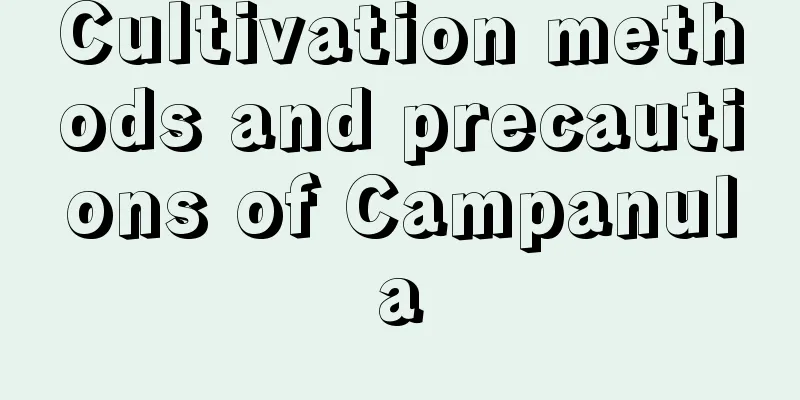Cultivation methods and precautions of Campanula

1. Maintenance methods1. Temperature: The temperature suitable for plant development is between 15 and 25 degrees. The temperature for wintering must be kept above ten degrees. Therefore, it is best to move plants planted in the north indoors for maintenance in winter. 2. Watering: The plant consumes a lot of water during the growing period, so the soil needs to be kept moist for a long time. Generally, water the plant once every two days. When it is not growing, water the plant appropriately, usually two to three times a week. When the temperature drops below minus ten degrees Celsius, cut off watering to avoid the water temperature being too low and aggravating the frostbite of the plants. 3. Fertilization: It likes fertilizer. When it blooms, the flowers bloom continuously, and the demand for nutrients is even greater. The nutrients in the soil alone are far from enough. Artificial fertilization is needed to meet its needs. Generally, during the growth period, it needs to be fertilized once every half a month. When fertilizing, use mainly compound fertilizers with mild fertilizer effects and easy absorption. You can also use homemade compost. Compost is made like this: put rotten fruit and vegetable peels and animal offal together, then bury them in the soil and let them ferment fully. After fermentation is complete, it becomes compost and can be used directly for plants. 4. Light: It is not resistant to strong light. Excessive light will cause the branches and leaves of the plant to curl and die, so it needs shading, especially in summer. It can be exposed to normal light in the morning and evening, but needs shading at noon. It is sufficient to ensure six hours of light a day. 2. Breeding techniques1. Reproduction: It can be propagated by sowing. The broadcasting method is used for breeding. Under temperature conditions of 15 to 25 degrees, the seeds will germinate in half a month. When it grows two true leaves, it is time to transplant it. 2. Pruning: The general method of pruning plants is to pinch the top. Pinching can promote the growth of lateral buds, avoid apical dominance, and make the nutrient distribution more even. After pinching, the incision should not come into contact with water for the time being. After the incision is dry, you can water it normally. 3. Problem Diagnosis1. Yellowing of branches and leaves: The yellowing of branches and leaves of campanula is mostly caused by excessive light. It is necessary to properly control the light and ensure that the plant will not be exposed to strong light. When irradiating, mainly diffuse light should be used, and this problem will be solved. 2. Root rot: Root rot may be caused by excessive watering, which leads to water accumulation in the pot soil and the soil is not breathable. You need to dig it out of the soil, cut off the rotten roots, and then replant it in soil with good air permeability. IV. Other issues1. Toxicity: non-toxic. 2. Edibility: It cannot be eaten directly, but it can be used as medicine. |
<<: Hypericum cultivation methods and precautions
>>: Bitter melon cultivation methods and precautions
Recommend
Can urea be used as topdressing fertilizer for Chinese cabbage (What is the correct way to apply urea to Chinese cabbage)
Chinese cabbage is a leafy vegetable. As we all k...
Do microbial agents have a rooting effect (promoting the growth of crop plant roots)?
Have farmer friends discovered a problem? No matt...
Tired of growing Chlorophytum comosum? Quickly change these 10 kinds of flowers, they are more beautiful and easier to grow
Love Vine 1. The suitable temperature for growth ...
Only grow these two kinds of "flowers" in winter, especially the second one, which can survive at minus 8 degrees Celsius
1. Schlumbergera When choosing soil for growing C...
What to do if azalea has buds but does not bloom
1. Increase air humidity Reason: Rhododendrons ar...
How to grow magnolia on the balcony, what should you pay attention to
1. Can it be grown on the balcony? Although magno...
Cultivation methods and maintenance matters of old millet star piles
How to grow millet star into an old pile The old ...
How to care for Dongyun succulents
Dongyun Succulent Growth Conditions Dongyun succu...
What is the Feng Shui effect of Qilin Palm?
Good luck to future generations Placing a Kylin p...
Edible and medicinal uses of sage
Edible Value of Sage On its own, sage has a stron...
How many sweet alyssum plants should be planted in one pot
How many sweet alyssum trees can be planted in on...
How often should potassium dihydrogen phosphate be sprayed (how long does it take for potassium dihydrogen phosphate to take effect after application)
Why are fake potassium dihydrogen phosphate produ...
What is the function of perfume grass
The ornamental effect of perfume grass The plant ...
Does the Jade Plant bloom?
Will it bloom? The Jade Plant will bloom, but due...
What kind of green plants are good to grow in the living room?
1. Chlorophytum You can grow spider plants in the...









